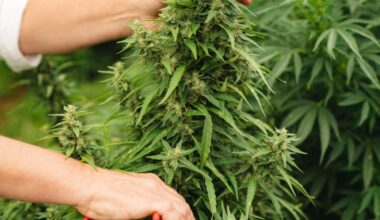With so many different non-intoxicating cannabinoids on the market, it can be hard to determine the differences between CBD and newer cannabinoid contenders like CBG and CBN. In this brief guide, learn the basics of what CBD, CBG, and CBN are, and discover how premier cannabinoid suppliers like GVB Biopharma can help you use each of these hemp compounds to boost your brand.
What is CBD?
Next to delta-9 tetrahydrocannabinol (THC), cannabidiol (CBD) is the world’s most famous cannabinoid. Originally rising to prominence due to the near-religious reverence it received from parents of children with intractable epilepsy, CBD soon became popular with people all around the world suffering from pain, inflammation, or even neurodegenerative diseases.
While THC primarily acts as a powerful agonist at your endocannabinoid system’s CB1 and CB2 receptors, CBD bypasses these intoxicating neuroreceptors altogether to primarily bond with your nervous system’s 5-HT1A and TRPV1 receptors. As a result, CBD doesn’t get you high, but it does provide a feeling of profound relaxation. CBD has been researched for its usefulness for a wide variety of different conditions, and the FDA has approved a CBD-based drug for certain types of epilepsy.

What is CBG?
Cannabigerol (CBG) is the decarboxylated form of cannabigerolic acid (CBGA), which is the chemical precursor for many cannabinoids. If it doesn’t decarboxylate into CBG, CBGA can also transform into THCA or CBDA, the carboxylic acid precursors of THC and CBD respectively. As a result, cannabis scientists have taken to calling CBGA the “stem cell” cannabinoid, and this unique hemp constituent becomes even more fascinating once it stabilizes into CBG.
While CBG is similar to CBD in many ways, this cannabinoid also has unique attributes. CBG has been researched for its potential digestive benefits, for instance, and this cannabinoid has also been researched for its potential antimicrobial qualities. These unique potential attributes have already differentiated CBG from other cannabinoids and carved out an enduring place for this hemp compound within the wider cannabinoid market.
What is CBN?
Both CBD and CBG can now be derived from strains of Cannabis sativa that have been bred to be high in these cannabinoids. At this time, however, there aren’t any hemp strains that are high in cannabinol (CBN), and instead, this cannabinoid is converted from CBD.
As evidenced by the ease of converting CBD into CBN, these cannabinoids are relatively similar. In terms of chemical composition, however, CBN is actually more closely related to THC than it is to CBD. At the same time, CBN does not significantly stimulate the brain’s CB1 and CB2 receptors, so it does not have intoxicating qualities.
Where CBN shows its similarity to THC most strongly is in this cannabinoid’s potential impact on appetite. CBN has been researched for its potential ability to boost appetite and reduce nausea, which has caused scientists to wonder if this cannabinoid might serve as a non-intoxicating alternative to THC for these purposes.
A small amount of research has also been conducted into CBN’s potential sleep benefits, but so far, this potential application of cannabinol is backed more by anecdotal testimony than it is by scientific evidence. As time goes by, we’ll learn more about CBN and its potential usefulness for sleep.
CBD vs. CBG vs. CBN
Now that you have an idea of what CBD, CBG, and CBN are, let’s discuss the differences between these cannabinoids in more detail to help you choose which hemp compounds you want to use in your products. As you’ll discover, however, you might want to use all three of these non-intoxicating cannabinoids instead of sticking with just one.
CBD is considered to be the gold standard among non-intoxicating cannabinoids, and it’s the hemp compound with which consumers are most familiar. Every good brand should offer at least one CBD product since consumers around the world reach for this cannabinoid.
CBG, on the other hand, is gradually gaining traction within the hemp market, and a significant fuss is being made over this cannabinoid’s potential digestive and antimicrobial attributes. Rather than being seen as an alternative to CBD, white label CBG is usually viewed as an add-on to the CBD experience.
Lastly, CBN is becoming popular among people who want to sleep better at night or overcome nausea. CBN isn’t as well-known as CBD or CBG, but the rising popularity of CBG has opened the door to acceptance of non-intoxicating cannabinoids other than CBD.
Cooperation instead of competition
While CBD, CBG, and CBN each have their unique attributes, they work best when used together. Full-spectrum and broad-spectrum extracts are usually only rich in a single cannabinoid, but premium cannabinoid suppliers like GVB Biopharma offer CBD, CBG, and CBN in isolate form as well, which is easy to combine with other types of hemp extract. Take advantage of the entourage effect today by blending all three of these non-intoxicating cannabinoids together.
Medical Disclaimer:
The information provided in these blog posts is intended for general informational and educational purposes only. It is not a substitute for professional medical advice, diagnosis, or treatment. Always seek the advice of your physician or other qualified healthcare provider with any questions you may have regarding a medical condition. The use of any information provided in these blog posts is solely at your own risk. The authors and the website do not recommend or endorse any specific products, treatments, or procedures mentioned. Reliance on any information in these blog posts is solely at your own discretion.






